对外汉语教学 中国菜
- 格式:ppt
- 大小:5.79 MB
- 文档页数:45


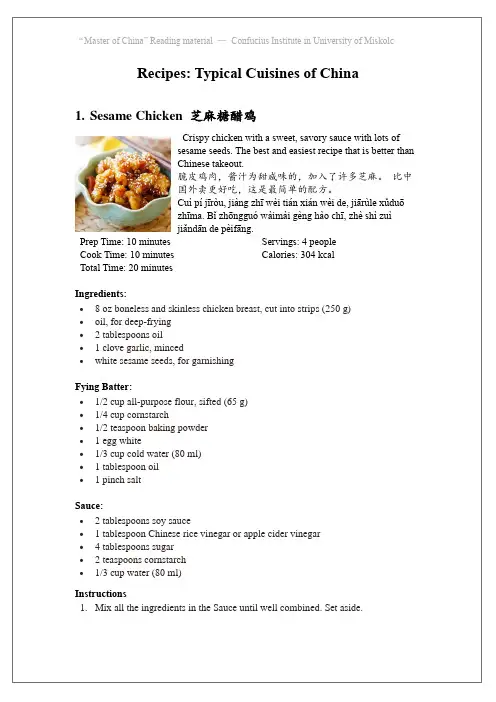
Recipes: Typical Cuisines of China1.Sesame Chicken 芝麻糖醋鸡Crispy chicken with a sweet, savory sauce with lots ofsesame seeds. The best and easiest recipe that is better thanChinese takeout.脆皮鸡肉,酱汁为甜咸味的,加入了许多芝麻。
比中国外卖更好吃,这是最简单的配方。
Cuì pí jīròu, jiàng zhī wèi tián xián wèi de, jiārùle xǔduōzhīma. Bǐ zhōngguó wàimài gèng hào chī, zhè shì zuìjiǎndān de pèifāng.Prep Time: 10 minutes Cook Time: 10 minutes Total Time: 20 minutes Servings: 4 people Calories: 304 kcalIngredients:•8 oz boneless and skinless chicken breast, cut into strips (250 g) •oil, for deep-frying• 2 tablespoons oil• 1 clove garlic, minced•white sesame seeds, for garnishingFying Batter:•1/2 cup all-purpose flour, sifted (65 g)•1/4 cup cornstarch•1/2 teaspoon baking powder• 1 egg white•1/3 cup cold water (80 ml)• 1 tablespoon oil• 1 pinch saltSauce:• 2 tablespoons soy sauce• 1 tablespoon Chinese rice vinegar or apple cider vinegar• 4 tablespoons sugar• 2 teaspoons cornstarch•1/3 cup water (80 ml)Instructions1.Mix all the ingredients in the Sauce until well combined. Set aside.2.Mix all the ingredients in Frying Batter in a bowl until well combined, stir a fewtimes to make sure there are no lumps and the batter is smooth. Add the chicken into the batter, stir to evenly coat with the batter.3.Heat 2 to 3 inches (5 to 7.5 cm) of the oil in a wok or a stockpot to 350°F(175°C) for deep-frying. Gently drop the chicken into the oil and loosen them up immediately with a spatula to prevent the chicken from clumping together. Deep-fry the chicken to golden brown. Remove the chicken from the oil with a strainer or slotted spoon, draining the excess oil by laying the chicken on a dish linedwith paper towels. Discard the oil.4.Heat up 2 tablespoons of the oil in a wok orskillet over high heat. Add the garlic and stir-fry until aromatic before adding the Sauce.5.As soon as the Sauce thickens, add the friedchicken into the wok or skillet. Stircontinuously until all the ingredients are wellcoated with the sauce. Dish out, garnish withthe white sesame, and serve immediatelywith steamed rice.Recipe NotesMy batter is very thick because it will makethe chicken extra crispy, even after addingthe sauce. If it's too thick to work with, add1-2 tablespoons water to loosen it up.2.Chow Mein 炒面Quick and easy stir-fried Chow Mein noodles with chicken,shrimp, vegetables with the best Chow Mein sauce. This isan authentic Chinese noodle recipe.用鸡肉,虾仁,蔬菜搭配最好的炒面酱,快速简单地炒炒面。
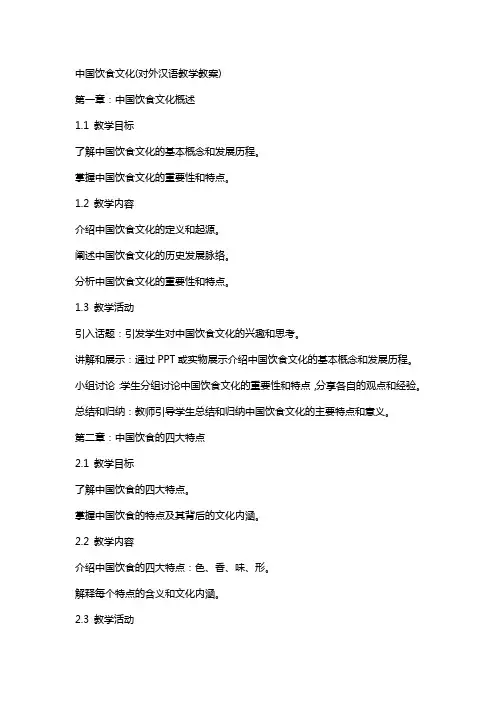
中国饮食文化(对外汉语教学教案)第一章:中国饮食文化概述1.1 教学目标了解中国饮食文化的基本概念和发展历程。
掌握中国饮食文化的重要性和特点。
1.2 教学内容介绍中国饮食文化的定义和起源。
阐述中国饮食文化的历史发展脉络。
分析中国饮食文化的重要性和特点。
1.3 教学活动引入话题:引发学生对中国饮食文化的兴趣和思考。
讲解和展示:通过PPT或实物展示介绍中国饮食文化的基本概念和发展历程。
小组讨论:学生分组讨论中国饮食文化的重要性和特点,分享各自的观点和经验。
总结和归纳:教师引导学生总结和归纳中国饮食文化的主要特点和意义。
第二章:中国饮食的四大特点2.1 教学目标了解中国饮食的四大特点。
掌握中国饮食的特点及其背后的文化内涵。
2.2 教学内容介绍中国饮食的四大特点:色、香、味、形。
解释每个特点的含义和文化内涵。
2.3 教学活动引入话题:引导学生对中国饮食的特点产生兴趣。
讲解和展示:通过PPT或实物展示介绍中国饮食的四大特点。
实例分析:通过具体的中国菜肴为例,分析其色、香、味、形的特点。
小组讨论:学生分组讨论中国饮食的特点及其背后的文化内涵,分享各自的观点和经验。
总结和归纳:教师引导学生总结和归纳中国饮食的四大特点及其意义。
第三章:中国传统节日饮食文化3.1 教学目标了解中国传统节日饮食文化的特点和意义。
掌握中国传统节日饮食文化的相关知识和实例。
3.2 教学内容介绍中国传统节日饮食文化的定义和特点。
讲解中国传统节日饮食文化的意义和作用。
举例介绍中国传统节日饮食文化中的具体菜肴和习俗。
3.3 教学活动引入话题:引发学生对中国传统节日饮食文化的兴趣和思考。
讲解和展示:通过PPT或实物展示介绍中国传统节日饮食文化的定义和特点。
实例分析:通过具体的传统节日为例,介绍其饮食文化和相关菜肴。
小组讨论:学生分组讨论中国传统节日饮食文化的意义和作用,分享各自的观点和经验。
总结和归纳:教师引导学生总结和归纳中国传统节日饮食文化的主要特点和意义。

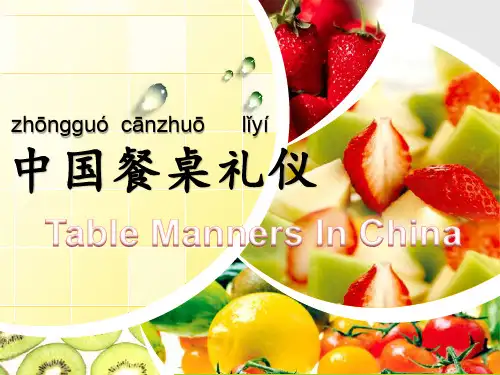
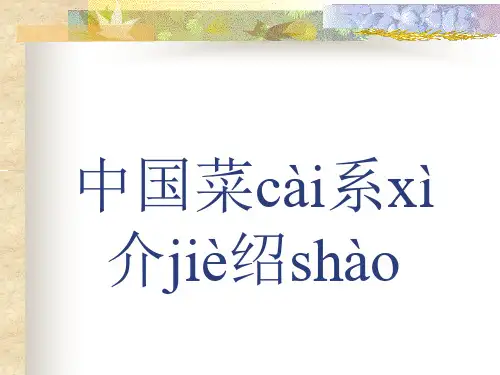
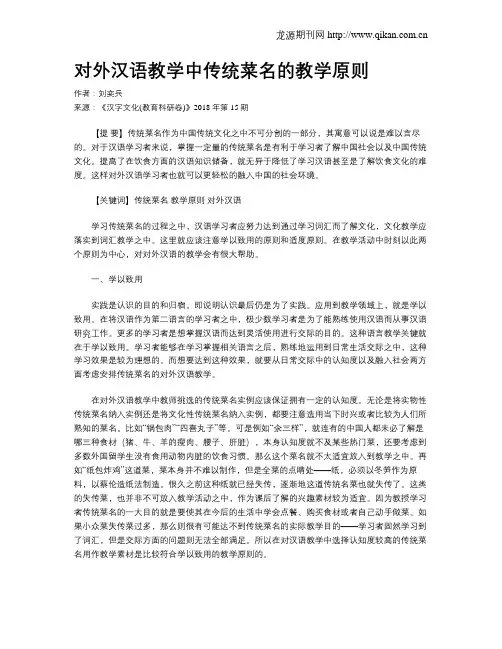
对外汉语教学中传统菜名的教学原则作者:刘奕兵来源:《汉字文化(教育科研卷)》2018年第15期【提要】传统菜名作为中国传统文化之中不可分割的一部分,其寓意可以说是难以言尽的。
对于汉语学习者来说,掌握一定量的传统菜名是有利于学习者了解中国社会以及中国传统文化。
提高了在饮食方面的汉语知识储备,就无异于降低了学习汉语甚至是了解饮食文化的难度。
这样对外汉语学习者也就可以更轻松的融入中国的社会环境。
【关键词】传统菜名教学原则对外汉语学习传统菜名的过程之中,汉语学习者应努力达到通过学习词汇而了解文化,文化教学应落实到词汇教学之中。
这里就应该注意学以致用的原则和适度原则。
在教学活动中时刻以此两个原则为中心,对对外汉语的教学会有很大帮助。
一、学以致用实践是认识的目的和归宿。
即说明认识最后仍是为了实践。
应用到教学领域上,就是学以致用。
在将汉语作为第二语言的学习者之中,极少数学习者是为了能熟练使用汉语而从事汉语研究工作。
更多的学习者是想掌握汉语而达到灵活使用进行交际的目的。
这种语言教学关键就在于学以致用。
学习者能够在学习掌握相关语言之后,熟练地运用到日常生活交际之中,这种学习效果是较为理想的。
而想要达到这种效果,就要从日常交际中的认知度以及融入社会两方面考虑安排传统菜名的对外汉语教学。
在对外汉语教学中教师挑选的传统菜名实例应该保证拥有一定的认知度。
无论是将实物性传统菜名纳入实例还是将文化性传统菜名纳入实例,都要注意选用当下时兴或者比较为人们所熟知的菜名。
比如“锅包肉”“四喜丸子”等。
可是例如“汆三样”,就连有的中国人都未必了解是哪三种食材(猪、牛、羊的瘦肉、腰子、肝脏),本身认知度就不及某些热门菜,还要考虑到多数外国留学生没有食用动物内脏的饮食习惯。
那么这个菜名就不太适宜放入到教学之中。
再如“纸包炸鸡”这道菜,菜本身并不难以制作,但是全菜的点睛处——纸,必须以冬笋作为原料,以蔡伦造纸法制造。
很久之前这种纸就已经失传,逐渐地这道传统名菜也就失传了。


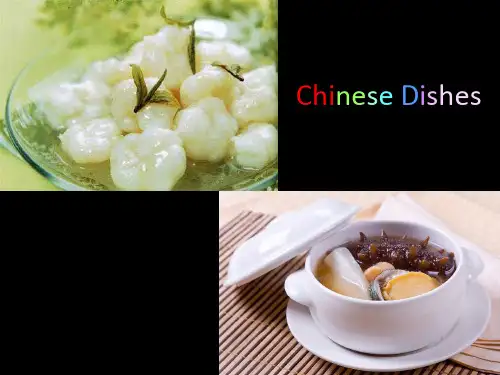
中国饮食文化(对外汉语教学教案)一、教学目标1. 让学生了解中国的饮食文化,包括食材、烹饪方法、餐桌礼仪等。
2. 提高学生的汉语听说读写能力,尤其是词汇和句型的运用。
3. 增强学生对中华文化的兴趣和认同感。
二、教学内容1. 中国饮食文化的概述2. 常见食材及其用法3. 烹饪方法介绍4. 餐桌礼仪须知5. 练习环节:角色扮演、小组讨论等三、教学方法1. 讲授法:讲解中国饮食文化的相关知识。
2. 互动法:引导学生参与讨论,分享自己的饮食文化。
3. 情景教学法:设置模拟餐桌场景,让学生实践餐桌礼仪。
4. 任务型教学法:分组完成相关任务,如制作简单的中式菜品。
四、教学步骤1. 导入:引导学生谈论自己喜欢的食物,激发兴趣。
2. 讲解:介绍中国饮食文化的基本知识。
3. 展示:展示图片或实物,让学生直观了解食材和烹饪工具。
4. 实践:学生动手尝试制作简单的中式菜品。
5. 讨论:分享制作过程中的感受,讨论中国饮食文化的特点。
6. 总结:回顾本节课的内容,强调重点。
五、作业布置1. 调查自己的饮食习惯,了解家乡的饮食文化。
2. 学习一首关于中国饮食文化的诗歌或歌曲。
3. 编写一个关于中国饮食文化的故事或短文。
六、教学内容1. 地方特色美食介绍2. 传统节日饮食习俗3. 饮食文化中的象征意义4. 中外饮食文化的差异5. 练习环节:美食推荐、文化差异讨论等七、教学方法1. 比较法:分析中外饮食文化的异同。
2. 案例分析法:通过具体的地方特色美食和节日饮食习俗,让学生深入了解中国饮食文化。
3. 小组讨论法:引导学生探讨饮食文化中的象征意义。
4. 任务型教学法:学生分组进行美食推荐,介绍给其他小组。
八、教学步骤1. 导入:回顾上节课的内容,引出本节课的主题。
2. 讲解:介绍地方特色美食和节日饮食习俗。
3. 分析:分析饮食文化中的象征意义。
4. 比较:讨论中外饮食文化的差异。
5. 实践:学生进行美食推荐,分享给其他小组。
6. 总结:回顾本节课的内容,强调重点。
中国饮食文化(对外汉语教学教案)一、教学目标1. 让学生了解中国的饮食文化背景及其特点。
2. 通过学习,使学生能够使用汉语描述中国的一些传统美食和饮食习惯。
3. 提高学生对中国饮食文化的兴趣和认识,促进文化交流。
二、教学内容1. 中国饮食文化的概述a. 中国饮食文化的历史发展b. 中国饮食文化的特点2. 中国的传统美食a. 各地特色菜肴b. 传统节日食品3. 中国的饮食习惯a. 餐桌礼仪b. 饮食健康观念三、教学方法1. 讲授法:讲解中国饮食文化的历史发展、特点、各地特色菜肴和传统节日食品等。
2. 互动教学法:通过小组讨论、角色扮演等方式,让学生参与进来,提高学生的积极性和兴趣。
3. 情景教学法:通过设定各种饮食场景,让学生在实际语境中学习汉语和了解中国饮食文化。
四、教学步骤1. 引入:通过展示一些中国美食的图片,激发学生的兴趣,引出本课的主题。
2. 讲解:讲解中国饮食文化的历史发展、特点、各地特色菜肴和传统节日食品等。
3. 实践:学生分组,每组选择一种中国传统美食进行研究,了解其制作方法和背后的文化意义。
4. 展示:各组向全班展示他们的研究成果,其他学生进行评价和讨论。
5. 总结:总结本课所学内容,强调中国饮食文化的重要性和特点。
五、作业1. 让学生选择一种中国传统美食,深入了解其制作方法和背后的文化意义,下节课向同学分享。
2. 让学生结合所学内容,写一篇关于中国饮食文化的短文,锻炼学生的写作能力。
六、中国的餐桌礼仪1. 教学目标a. 让学生了解中国餐桌礼仪的基本规范。
b. 使学生能够在实际场景中运用汉语描述中国餐桌礼仪。
2. 教学内容a. 餐桌礼仪的基本原则b. 用餐过程中的注意事项c. 不同场合的餐桌礼仪3. 教学方法a. 讲授法:讲解餐桌礼仪的基本原则和注意事项。
b. 情景模拟:模拟不同场合的餐桌场景,让学生实际操作,纠正不当行为。
4. 教学步骤a. 引入:通过一些关于餐桌礼仪的趣事,引起学生对中国餐桌礼仪的兴趣。
The Four Famous Chinese Cuisines 中国四大菜系People regard food as their prime want, and food safety is a top priority.民以食为天,食以安为先.Cooking is an ancient Chinese art. Some 3,000 years ago, the Chinese people already knew how to “deliciously” blend the five flavors 五味-pungent 辛(辣),sweet 甘(甜),sour 酸,bitter 苦,and salty 咸and today Chinese cuis ine is ranked among the world’s best and Chinese restaurants can be found in many countries and regions throughout the world.Chinese cooking places great stress on the colour(色), fragrance(香), taste(味), form (形)and nutrition of the food and is very particular about cutting and temperature control. According to the rough estimates, there are more than 5,000different local cooking styles in China. The most popular cooking styles in China are those of Sichuan, Guangdong, Shandong, and Huaiyang (jiangsu).As early as the Qing Dynasty (1644-1911), some overseas Chinese opened Chinese restaurants in England and other countries and regions. Since then, Chinese cuisine has been popular the world over.The Chinese cooking is very delicate and has a great variety, It is agreeable to different races of people all over the world.Diet is a kind of civilization of humanity and cooking is a superb art. With the development of social productive forces, and the increase of international exchanges, the Chinese cookery art is sure to be further improved. But it is a pity that only a few books were written about the Chinese cuisine in ancient times.Sichuan Style 四川菜Distinct features of Sichuan Style: They prefer steaming, simmering, and smoking, The cooking is elaborate and meticulous and the flavouring highly varied and mixed. The taste of each dish is very distinct. A common Chinese saying about Sichuan cuisine is that each meal has its own unique taste, and no two dishes have the same flavour.Sichuan cooking employs scores of condiments giving all the different tastes-salty, sweet, sour, hot, aromatic, peppery or bitter, of which a prickly pepper is the climate, the chefs there lean heavily on such warmth-giving ingredients as chilli pepper, black pepper, the mild red huajiao pepper, and ginger. Of hundreds of varieties of Sichuan dishes, it is said that only 20 per cent have a hot and numbing effect on the palate. In fact, the art of Sichuan cooking emphasizes the aesthetic appeal of food. It offers everything pleasant and inviting to colour, aroma, and appearance, while flavour is the top priority. What Sichuan cuisine boasts is an abundance of flavour and diversified methods of cooking. Guangdong Style 广东菜Guangzhou food is a representatative of Guangdong foods, including all the delicacies of Guangdong, Chaozhou, Dongjiang, and Hainan Island. Guangdong food has absorbed some elements of Beijing, Suzhou, Yangzhou, and Hangzhou cuisine, while keeping its South China flavour.In preparing the Guangdong cuisine, dozens of varieties of ingredients are often involved and more than 30 different kinds of cooking methods employed, such as frying, grilling, stewing, simmering, deep-frying, roasting, and braising etc. Freshness is everything to the Guangdong cuisine. So is quick cooking: there is not much long broiling or barbecuing asin North China. Also, there is no simmering for hours with spices and herbs like in the West. The objective is freshness, tenderness, smooth texture, and piquant flavour. These qualities are especially evident in another Guangdong specialty-roast suckling pig. A piglet is gutted and coated inside with fermented bean curd, sesame paste, fen liquor, and garlic-flavoured sugar, and then roasted until its skin is golden-red and shiny as lacquer. The custom is to eat the crisp, crackling skin first, and then the tender, smooth-textured flesh.Shandong Style 山东菜Shandong cuisine is known for its light seasoning, and delicacy. Its chefs make a point of retaining the original flavour, freshness, crispness, and tenderness of the ingredients. Among its specialties are Sweet-sour Huanghe (Yellow River) carp, fried crisp on the outside but tender that the meat can be shaken off the bones and melts deliciously in the mouth. Chefs in the coastal cities of Qingdao and Yantai excel in the preparation of seafood.Shandong cuisine is also known for its soup, both the clear and milky-white kinds. One clear type, prepared with materials extracted from swallow’s nests, is often the first major course at banquets. (soup usually comes at the end of most Chinese meals) White soup made with wild rice stems or dandelion greens is famed for colour, fragrance, taste, and appearance.Shandong food consists of Jinan and Fushan food. Jinan food makes good use of soup seasoning, frying in deep oil and steaming. Shandong roast chicken is especially good with wine and the chicken is tasty and tender. Tasting it is guaranteed to make the diner believe.Huaiyang (Jiangsu) Style 淮扬(江苏)菜The origin of Huaiyang cuisine can be traced to pre Christian times. The clear simmered soft-shelled turtle, a Huaiyang specialty, was listed in the famous delicacies mentioned in an ancient verse by Qu Yuan (c.340-c.278 BC), one of the greatest poets in Chinese history. Yangzhou, where Huaiyang cuisine originated, remained an important economic and salt-trading centre for more than 1,000 years, as the famous Beijing-Hangzhou Canal passed through there. The traders and men of letters from the North and South gathered there. They became patrons of the many local restaurants, which competed with each other for customers. The most important patron of the Huaiyang cuisine was Zhu Yuanzhang(1328-1398, reigned 1368-1398), founder of the Ming Dynasty (1368-1644). Impressed by the local cuisine when he took control of Yangzhou as the leader of a peasant rebellion, Zhu Yuanzhang designated it as the imperial court kitchen master in Nanjing, the first capital of the Ming Dynasty.When the third Ming emperor Yongle (1360-1424, reigned 1403-1424) moved the capital from Nanjing to Beijing in 1421, he brought the Huaiyang chefs with him.Huaiyang specialties are lightly flavoured, whether they combine sweet-and-sour or sweet-and-salty tastes. Soy sauce and spices are mild and used sparingly, although the use of rich-flavoured broth is extensive.The Four Famous Chinese CuisinesSichuan food is famous for its numerous varieties of delicacies and strong flavors and is best known for being spicy-hot.宫保鸡丁:Kung Pao chicken回锅肉:twice cooked pork often with chilli seasoning麻婆豆腐:MarBoh TofuCantonese cuisine emphasizes light cooking with seemingly limitless ingredients.龙虎斗:the Battle Between the Dragon and the Tiger盐火局鸡:Salt-Baked Chicken冬瓜盅:Wax Gourd SoupShandong dishes feature choice of ingredients, adept technique in slicing and prefect cooking skill.糖醋鲤鱼:Fried carp with sweet and sour sauce德州扒鸡:Braised Chicken, Dezhou StyleYangzhou cuisine emphasizes the original flavor if well-chosen materials.松鼠桂鱼:Squirrelshaped Mandarin Fish盐水虾:Boiled shrimps with saltFamous Beijing dishes:北京烤鸭:roast Beijing duck四喜丸子:Sixi Balls全聚德王府井Shanghai local delicacies:白斩鸡:Boiled chicken狮子头:minced pork ball大闸蟹:fresh water crab南翔小笼:Nanxiang steamed stuffed bunOther famous Chinese dishes:佛跳墙:Buddha jumping out of wall糖醋排骨:Sweet and Sour Pork东坡肉:stewed Dongpo pork in soy sauce。
对外汉语文化课《火锅》教案课型:新授教学对象:中高级汉语学习者教学目标:1.了解中国饮食文化——火锅的发展历史。
2.了解盛火锅器物的演变。
3.熟知中国各地特色火锅。
4.掌握吃火锅的方法。
教学难点及重点:1.生词。
“鼎、釜、暖锅、涮、潮汕、蘸料、酥”。
2.中国各地特色火锅特点。
3.盛火锅器物的形状特点。
教学环节:一、组织教学:通过一个小短片来导入,怎样吃火锅。
二、Ppt讲解三、课文小结四、布置作业教学步骤:1.导入新课,视频引起学生兴趣。
Tony和他的朋友第一次去火锅店吃火锅,不知道怎么点菜,那么该怎么办呢?2.进入主题,介绍中国文化-火锅:火锅的历史;火锅的种类;火锅的吃法。
3.通过一个小短片来了解中国火锅的历史。
4.介绍盛火锅的器物:“鼎、釜、暖锅”鼎特点。
鼎:主要用途是煮食物,鼎的四条腿便是灶口和支架,腹下烧火,可以用来煮食物;釜:圆底无足,必须安置在灶炉上或是其他物体用来支撑物体;暖锅:圆形,上大下小,上为锅,下为底座。
锅的中间,竖起一个上小下大的圆筒状烟道,通道底座,可以用来掏灰,更重要是通风,那样炭火会越烧越旺。
5.中国各地特色火锅:老北京涮羊肉火锅——采用了铜碳火锅,因为他是清汤锅底,所以最大限度保障了羊肉的鲜美。
羊肉肉质细腻并且没有膻味,将切成薄片的羊肉放进锅里,涮一涮,就变熟了。
再蘸料吃,那简直就是鲜嫩多汁啊。
是不是看看口水都要流下来了;苏杭菊花火锅——火锅汤汁是鸡汤或者肉汤,并加上鱼,肉,鸡等食材和菊花一起涮着吃,那真的是味道鲜美,清香爽口,吃再多也不油腻;潮汕火锅——潮汕就是指广东地区。
潮汕火锅最传统的做法是将沙茶酱加入锅中,用浓汤做锅底,后来随着发展,锅底就只剩牛股清汤和白萝卜了,还可以加入图片中的玉米。
这样更利于尝出牛肉本来的味道.;重庆火锅——重庆火锅又称麻辣火锅,是中国传统饮食方式之一,其起源于明末清初的重庆嘉陵江畔、该菜式也是朝天门等码头船工纤夫的粗放餐饮方式,。
6.吃火锅有哪些荤菜——肥牛、牛肉丸、酥肉、午餐肉;素菜——海带、土豆片、娃娃菜、宽粉。